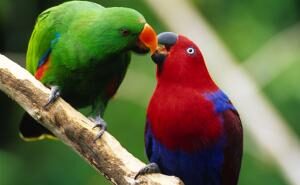
Photo: ECLECTUS Roratus, Lorius Roratus
Kingdom: Animals
Type: chordal
Class: Birds
Squad: parrot
Family: Parrot
Subvenuation: Real parrots
Body length 35-40 cm; weight up to 450 g. The color of males and females varies greatly. In males, the main color is green with a blue reflection on the tops of the wings and under the wings, the edges of the wings are blue-blue, the tails of the tails are yellowish-green, shells and sides red. The beak is multi -colored: the upper jaw is red and shiny, the tip is yellow, the lower jaw is black. The iris is orange. The legs are gray. Red-cherry color prevails in the plumage of the female. The edge of the wing, the lower chest and the stomach is blue-violet. The tail is red, trimmed with a yellow stripe. Subsidiary and shelter red. Around the eyes the blue ring. The beak is black. The iris yellowish. The legs are bluish. For a long time, ornithologists even considered males and females different species.
It lives in the north of Australia (PEC Cape York), Southern Molucca, Solomon Islands and New Guinea.
Inhabit thick tropical forests at an altitude of 600—1000 m above sea level. More often lead a single lifestyle, but packs are also found. It feeds on fruits, seeds, juicy buds, flowers and nectar.
Nesting in the most common forest, in hollows of tall trees located at an altitude of 20-30 m from the ground. Propagating females never leave the environs of their nesting tree. A month before the start of laying, they climb into their hollows and sit there for most of the time, sticking out the bright red head or the entire upper body of the body. In the masonry 2 eggs, the female against 26 days impendes. Males spend a significant part of the time collecting food for the female, and then for the chicks. Males are not allowed in the hollow — Having taken the food brought from them, the female herself distributes it between the chicks.
In Europe appeared in the middle of the XIX century. These are rather calm phlegmatic parrots. At home, they quickly tame. Some of them can even learn «speak», but mostly they are held for the beauty of the plumage. Life expectancy 40-50 years. Propagate rarely.
Includes 6-12 subspecies.
- ECLECTUS RORATUS ARENSISS G. R. Gray, 1858 — Body length 37 cm. Widespread on the island of aru.
- ECLECTUS Roratus Biaki (Hartert, 1932) — Body length 35 cm. Perhaps a variety of eClectus r. Polychloros.
- ECLECTUS Roratus Cornelia Bonaparte, 1850 — Body length 37 cm. Distributed on about. Suma.
- ECLECTUS Roratus Macgillivrayi Mathews, 1913 — Body length 40 cm. Distributed in the east of the Cape York Peni (North Australia).
- Eclectus Roratus Polychloros (Scopoli, 1786) — Body length 37 cm. Distributed on New Guinea, Salavati Islands, Batanta, Waigeo, Kai, Triang, D’Antrkasto and Louisiada Archipelago.
- ECLECTUS Roratus Riedeli Meyer, 1882 — Body length 33 cm. Distributed on the islands of Tanimbar.
- ECLECTUS Roratus Roratus (Muller, 1776) — Body length 35 cm. Distributed on the islands of Boer and Seram (Molucca Islands).
- ECLECTUS RORATUS Solomensis (Solomonensis) Rothschild & Hartert, 1901 — Body length 37 cm. Distributed on Solomon Islands, Bismarck Archipelago and Aska of Admiralty.
- ECLECTUS RORATUS VOSMARI (RothSchild, 1922) — Body length 38 cm. Distributed to the northern and central Molucca Islands: Halmacher, Morotai, Batjan, Ob, Damar, Mare and Kayao.
- ECLECTUS Roratus Westermani — Body length 33 cm. Known only for 11 copies in the museum (5 males and 6 females). Some researchers suggest that this is a hybrid between ECLECTUS R. VOESMARI and ECLECTUS R. Roratus or Eclectus R. Riedeli.